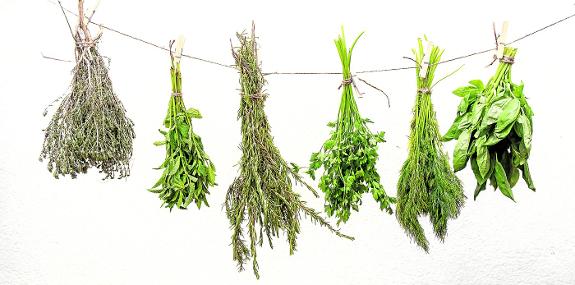Aromatic herbs: green magic
The best ways to preserve herbs and use them to add an aromatic touch to dishes
ESPERANZA PELÁEZ
Martes, 4 de junio 2019, 12:47
Aromatic herbs are among some of the oldest ingredients in the kitchen and as gastronomy has become a cultural event and eating has become more sophisticated it is clear from old Roman, Arab and medieval recipes that we have lost a great wealth of knowledge.
Without straying from Mediterranean shores we can link basil and sage with Italy, dill and oregano with Turkey and Greece, tarragon with France, mint with Morocco and coriander with Portugal. Coriander, today the most consumed herb in the world, was brought to America by the Spaniards, who then abandoned its use for centuries as a diabolic plant associated with Sephardic cuisine. In exchange, parsley, bay, thyme, rosemary, oregano and mint were kept.
Unlike a spice, which can be the root, seed, bark or fruit of a plant generally preserved dried, with aromatic plants the leaves are used. As Harold McGee points out in 'On Food and Cooking', these are vulnerable plants that have developed aromatic defensive compounds that are highly volatile (i.e. prone to be release into the air with little provocation or be released when chewed) to keep pests and predators at bay.
In the distant past there was an obsession to find medicinal values for any plant or spice. Some do have medicinal properties, and it is important to remember that in massive quantities any medicine can be poison. But don't worry, for most the risk of forgetting aromatic plants or resorting perhaps to buying poor quality herbs in jars from supermarkets is greater. In order to make the most use of aromatic herbs it is necessary to understand its natural chemical components which are essential oils, so they are released better in contact with other oils or by the dissolving power of vinegars and alcohol rather than water.
Another aspect to take into account is the type of plant. The best known in our culture form part of two great botanical families, the lamiaceae (savory, basil, lavender, marjoram, lemon balm, mint, oregano, sisho, thyme, rosemary, sage) and apiaceae (celery, coriander, dill, fennel, parsley). The difference between the two for culinary purposes is that the aromatic compounds in the former are in glands on the surface of the leaf. In general they are more perceptible by smell, while in apiaceae they are found in the veins of the leaves and stems and develop better when chewed.
Generally speaking, the laminaceae are more resistant to drying (except for basil) and can be preserved in oils and in vinegar while the apiaceae respond well to freezing. If you are using fresh herbs and want to keep them for a few days they can be washed, patted dry and wrapped in kitchen paper before placing in the fridge. Basil, however, is best kept outside the fridge in a glass of water, a sit does not keep well when cold. It can also be preserved in oil or made into pesto which freezes well.
The fragile leaves of mint, parsley, coriander and basil should be added near the end of the cooking time, to preserve their fresh flavour. The stalks of parsley and coriander can be tied in bunches and cooked for longer.
Chopping pungent herbs develops their flavour. If you want to use parsley for garnish, fine, but if you want it to shine on the plate, chop it fine; also thyme or rosemary leaves if you're going to use them in a marinade. However, if you are going to use these powerful herbs in a slow cooked dish, put them in whole, and remember steam is a good conductor if you want to add a final touch of herbs. Another way to increase their flavour is to heat them in oil, something that is often done in sage dishes in Italy.
Jill Norman, author of 'Cooking With Herbs And Spices', recommends heating the oil (50º C is more than enough) to make aromatic oils.
And one last tip: use herbs to bring salads to life. Not just parsley, coriander or mint, but any tender leaf herb you fancy, including fresh oregano, fennel or dill, any of them capable of making the most boring mixture of leaves unforgettable.
